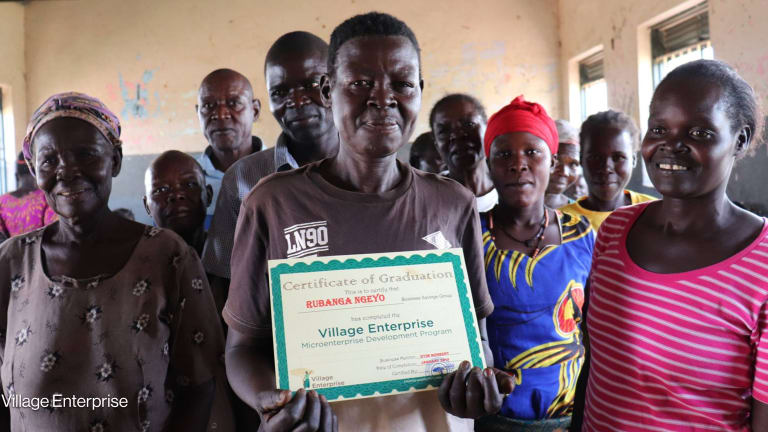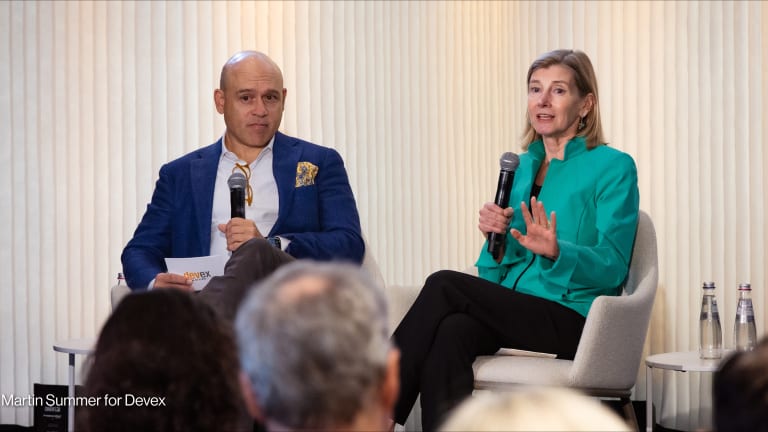Is there life after leadership?
Founders and CEOs can find it hard to hand over the reins of an organization. Devex speaks to those making the leap about how to ensure a smooth transition.
BRUSSELS — Rich Stearns, the outgoing president of World Vision United States, has seen many boards talking about their leader, asking each other “When is the old boy going to retire?” “I don’t want people whispering about me in the hallways,” he told Devex recently after announcing plans to step down after 20 years in the job. “I feel good about what I’m doing right now but I do think it’s time for a new leader, and I want to give the organization the best possible chance to have a smooth transition.” Stearns, who joined World Vision from the private sector, acknowledges that two decades is a long time in the role. “Most leaders shouldn’t stay for 20 years. I don’t necessarily recommend that for everyone,” he said. “I think you have to reinvent yourselves multiple times over a period that long … otherwise you’ll get really stale.” It has often been written that the best measure of a leader’s success is how well the organization fares once they are gone. Devex spoke to founders and leaders who have made the leap for their advice on when, why, and how to move on from an organization. They shared some of the practical challenges, such as how to ensure a smooth leadership transition, as well as some of the personal challenges about how to step back or manage a future relationship with the team. The picture is complicated when a leader is also the group’s founder, said Mari Kuraishi, who is stepping down as president of GlobalGiving, a foundation connecting nonprofits with donors, which she co-founded in 2002. In the for-profit sector, Kuraishi said, founders might receive lucrative compensation to yield to someone with more experience. “They have an interest in their venture doing as well as possible. Their stock is going to be more valuable if a seasoned leader takes it to the next level,” she said. For nonprofit leaders, however, “when you leave you are not equipped with stuff to do more of what you’ve been good at. And in fact, you lose the standing that you had as the founder … You can’t attend the same events. You can’t hang out with the same people you’ve been hanging out with externally without this platform.” Without that “institutional identity,” Kuraishi said, “it’s like dropping into the abyss, unless you find another gig.” Stearns, Kuraishi, and others offered these top tips. Know when to go In 2008, David de Ferranti founded Results for Development, an NGO working mostly on health, education, and governance issues in Africa, Asia, and Latin America. Five years in, he started to think about how to manage a transition to the next leader. He wanted the satisfaction, “not just to create something but to step away and see it fly on its own.” In 2015, he turned 70. “Bad things happen to people in their seventies and it is irresponsible of a CEO to expose an organization to the risk of having someone who is hanging around too long,” de Ferranti said. His successor, Gina Lagomarsino, took over in 2016 at the age of 43. Knowing when to go is the first recommendation de Ferranti said he would give peers considering their future. “It sounds simple but when it gets up-close people don’t remember or understand that it is time to go,” he said, adding that the well-being of the organization often depends on it. Kuraishi agreed. “It’s a great gig,” she said of her role as president. “It’s designed the way I want it, financially we’re extremely sound, I have an awesome team. I could keep doing this for a long time but I don’t think it would be the right thing for GlobalGiving.” She sees her departure as an opportunity both “to bring in someone amazing who will take the organization to a new level and a new place,” and for herself. “If I want to go out there and find another gig, I should do it before I’m too closely identified with this one thing in my life, otherwise it looks like I can’t do anything else.” Get the house in order The leaders all emphasized the importance of giving their successor a clean slate. “You can’t leave a scrappy startup that has trouble making payroll and expect somebody else to take care of it,” Kuraishi said. “It sounds simple but when it gets up-close people don’t remember or understand that it is time to go.” --— David de Ferranti founder of Results for Development On her to-do list before she leaves were things like reorganizing internal processes on budgeting and approval lines, as well as finalizing a registration in China. Both she and de Ferranti also addressed what Kuraishi called “lingering personnel issues” ahead of the transition. Stress test first One way to check whether an organization is ready to fly on its own is to take a sabbatical. Kuraishi said senior team members at GlobalGiving were given the opportunity to take three months off, allowing everyone to “make sure that the wheels of the bus didn’t fall off.” “I would very much recommend it,” she said. “Coping while someone is on vacation is easy, [but] three months is a quarter of a year. Can you make do without someone in a senior leadership position for that long? What are some of the skills the second-level directors need to have in order to fill in? It’s really good practice for the board [and] it’s good for the staff and the people right below them to … [fill in] the gaps.” The idea, she said, is to help people realize that “no one is indispensable.” Take time to transition Stearns said he gave the board two years to plan for his departure, while World Vision staff were formally notified in January that he will leave at the end of this year. The change is made easier, he said, by a chief operating officer hired three years ago who is already largely “running the show” and thus able to provide continuity and stability. That COO, Edgar Sandoval Sr. was announced in May as Stearns’ successor. Stearns plans to overlap with Sandoval for three to six months as part of an onboarding process, allowing for introductions to staff and key stakeholders. Kuraishi is planning to overlap with her successor, too. She wants to make the introductions to GlobalGiving’s supporters herself, “so that it is not someone showing up at a networking event and no one recognizing their face.” Know thyself When Lagomarsino became CEO, de Ferranti stayed on as chairman of the board, at their request. For him, conventional business-school thinking about the need for outgoing leaders to completely leave an organization is “oversimplified.” Instead, he believes much depends on the personalities of those involved. He urged CEOs who were thinking about keeping a role within the organization to “know your own personality, your own character, and ask yourself ‘can I really step away? Am I the sort of leader who can make space for a successor?’” Kuraishi said she may stay on as a board member too, and that was made clear to those applying to replace her. “If the candidate was the kind of person who said ‘I don’t want any of the founders around’ then they were going to self-select out,” she said. “[The board] felt … that as founders we were part of the DNA of the organization at the governance level.” ‘Don’t fall for a shiny object’ Across the sector, Stearns said the reason some NGOs have eight presidents in 15 years is that often the volunteer-run board “blew it” by failing to consult staff about what they need in a leader. “I’ve told our board, ‘don’t fall for a shiny object because you get a chance to get somebody who is maybe nationally known, or they got some kind of shiny resume, or maybe they are a celebrity,’” Stearns said. “Ask the question: ‘Can this individual raise $3 million a day, 365 days a year?’ Because that’s what I have to do in this job.” In the fall of 2015, de Ferranti announced that he would be stepping down as CEO in a year’s time, and from there it took six months to choose Lagomarsino, who started in fall 2016. As his preferred internal candidate, de Ferranti had already begun preparing Lagomarsino for the role, including by making her chief operating officer, though R4D also considered replacements from outside the organization. Part of de Ferranti’s preparation with Lagomarsino involved bringing her into the decision-making process, he said. “We’d be in management meetings where I was chairing as the CEO, and we’d get to a big issue and the group would be talking about it and it was time to make a decision and I would then consciously say ‘well, Gina, what do you think?’ And I would try to go with her decision. So she was COO, and I was blessing that decision.” One of Lagomarsino’s first tasks as CEO was to set R4D’s new strategic direction of working less outside the group’s core areas such as health, education, and citizen participation. “She wanted to go with the narrower focus,” de Ferranti said. “I gave her my thoughts on some of the pluses and minuses of that, but then we were very clear that ‘this is your decision Gina. My role at this point is to be a thought-partner for you, give you ideas but to make clear you are the decision-maker now.’” Adva Saldinger contributed reporting to this story.
BRUSSELS — Rich Stearns, the outgoing president of World Vision United States, has seen many boards talking about their leader, asking each other “When is the old boy going to retire?”
“I don’t want people whispering about me in the hallways,” he told Devex recently after announcing plans to step down after 20 years in the job. “I feel good about what I’m doing right now but I do think it’s time for a new leader, and I want to give the organization the best possible chance to have a smooth transition.”
Stearns, who joined World Vision from the private sector, acknowledges that two decades is a long time in the role. “Most leaders shouldn’t stay for 20 years. I don’t necessarily recommend that for everyone,” he said. “I think you have to reinvent yourselves multiple times over a period that long … otherwise you’ll get really stale.”
This story is forDevex Promembers
Unlock this story now with a 15-day free trial of Devex Pro.
With a Devex Pro subscription you'll get access to deeper analysis and exclusive insights from our reporters and analysts.
Start my free trialRequest a group subscription Printing articles to share with others is a breach of our terms and conditions and copyright policy. Please use the sharing options on the left side of the article. Devex Pro members may share up to 10 articles per month using the Pro share tool ( ).
Vince Chadwick is a contributing reporter at Devex. A law graduate from Melbourne, Australia, he was social affairs reporter for The Age newspaper, before covering breaking news, the arts, and public policy across Europe, including as a reporter and editor at POLITICO Europe. He was long-listed for International Journalist of the Year at the 2023 One World Media Awards.








